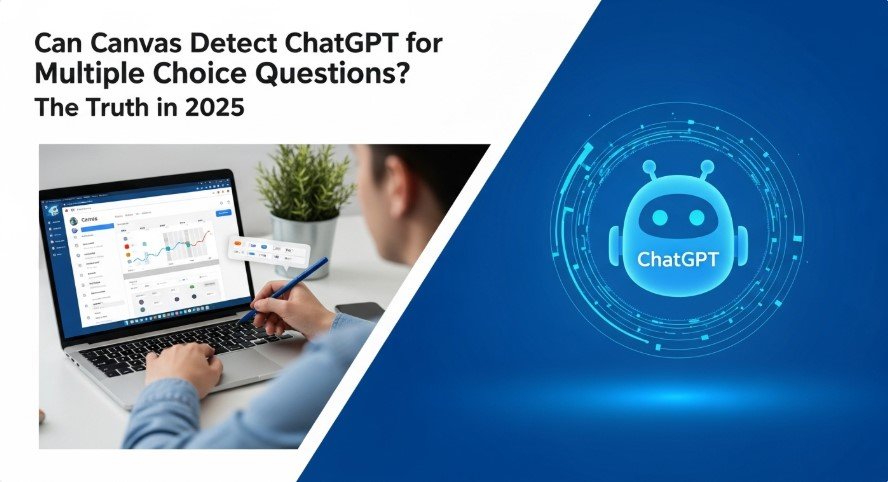In today’s digital classrooms, tools like ChatGPT are changing how students learn. Canvas, a popular learning management system (LMS), is widely used for managing courses and quizzes. A common question is: can Canvas detect ChatGPT use in multiple-choice questions? This article explores Canvas’s capabilities, detection methods, and ethical considerations for students and educators as of 2025.
What is Canvas?
Canvas is an online platform used by schools and universities. It helps teachers create courses, share materials, and give quizzes. Students use it to submit assignments, take tests, and check grades. Its simple design makes it a top choice for online education.
What is ChatGPT?
ChatGPT, created by OpenAI, is an AI tool that generates human-like text. It answers questions, writes essays, and solves problems. Students may use it to study or, in some cases, to complete quizzes. While it’s a helpful learning tool, misuse raises concerns about fairness.
Can Canvas Detect ChatGPT?
Canvas itself does not have built-in AI detection for ChatGPT as of 2025. However, several methods can flag potential AI use:
- Third-Party Tools: Schools often integrate tools like Turnitin with Canvas. Turnitin can detect AI-generated text by analyzing patterns, but it’s less effective for short answers like multiple-choice responses.
- Behavioral Tracking: Canvas logs data such as quiz completion time and mouse clicks. Unusually fast answers may suggest AI use.
- Instructor Oversight: Teachers can spot inconsistencies, like sudden improvements in quiz scores, that hint at AI assistance.
Sources confirm Canvas relies on external tools and instructor judgment for detection, not native features.
Challenges in Detecting ChatGPT for Multiple-Choice Questions
Detecting AI use in multiple-choice quizzes is tough. Here’s why:
- Short Answers: Multiple-choice responses (e.g., “A” or “B”) are too brief for AI detection tools to analyze effectively.
- External AI Use: Students may use ChatGPT outside Canvas, leaving no direct trace.
- Time Analysis: Canvas tracks how long students take on quizzes. Answering 20 questions in under a minute might raise suspicion, but it’s not proof of AI use.
- Proctoring Tools: Some quizzes use lockdown browsers or webcam monitoring to catch external tool use, but not all do.
Explore how other platforms detect AI in our article on Blackboard and ChatGPT.
How Instructors Spot AI Use
Teachers rely on more than just technology to detect ChatGPT:
- Performance Comparison: A sudden jump in quiz scores compared to past work can signal AI help.
- Follow-Up Questions: Instructors may ask students to explain answers in person or in writing to check understanding.
- Classroom Engagement: Discussing quiz topics in class can reveal if a student’s knowledge matches their quiz performance.
Learn more about AI detection in education with our Gradescope analysis.
Ethical Use of AI in Education
Using AI like ChatGPT raises ethical questions. It can aid learning but shouldn’t replace effort. Here’s how to use it responsibly:
- Students: Use ChatGPT to clarify concepts or practice, not to submit answers. Check your school’s AI policy to avoid penalties like failing a course.
- Educators: Set clear AI rules. Design quizzes that require critical thinking, such as open-ended questions, to reduce AI reliance.
Read our guide on humanizing AI content for tips on responsible use.
Tips to Avoid Detection (and Stay Ethical)
If you use ChatGPT, follow these steps to stay honest:
- Paraphrase Ideas: Rewrite AI-generated ideas in your own words.
- Add Personal Insights: Include examples or thoughts unique to you.
- Check School Policies: Know what’s allowed to avoid trouble.
- Use AI for Learning: Study with ChatGPT, but answer quizzes yourself.
See how to use ChatGPT for research planning.
The Future of AI Detection in Canvas
As AI tools evolve, so do detection methods. Schools may adopt advanced tools or stricter proctoring to catch AI use. Meanwhile, designing quizzes that test critical thinking can reduce reliance on AI. Both students and educators must adapt to balance technology and integrity.
Conclusion
Canvas likely cannot detect ChatGPT for multiple-choice questions directly, but tools like Turnitin and instructor oversight can flag suspicious activity. Students should use AI ethically to avoid consequences, and educators should create fair assessments. Stay informed and use AI as a tool, not a shortcut.
For more insights, check out:
- Can Universities Detect Paraphrased ChatGPT?
- How to Detect if Students Used ChatGPT
- Does SafeAssign Detect ChatGPT?
People Also Ask
| Question | Answer |
|---|---|
| Can Canvas detect ChatGPT? | Canvas itself cannot detect ChatGPT, but third-party tools like Turnitin may flag AI use. |
| Does Turnitin catch AI answers? | Turnitin can detect AI-generated text in longer responses but struggles with short answers. |
| How do teachers spot ChatGPT use? | Teachers notice performance changes, rapid quiz times, or use detection tools. |
| Is using ChatGPT cheating? | It depends on your school’s rules. Using AI without understanding the material is often considered cheating. |
| Can Canvas track new tabs? | Canvas alone cannot track tabs, but proctoring software might. |
